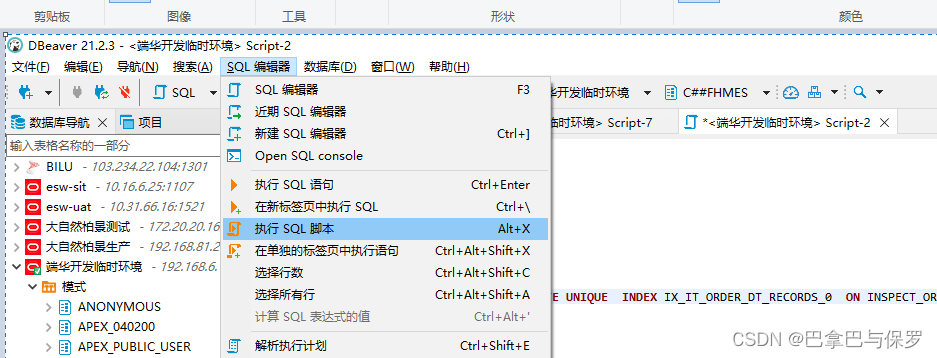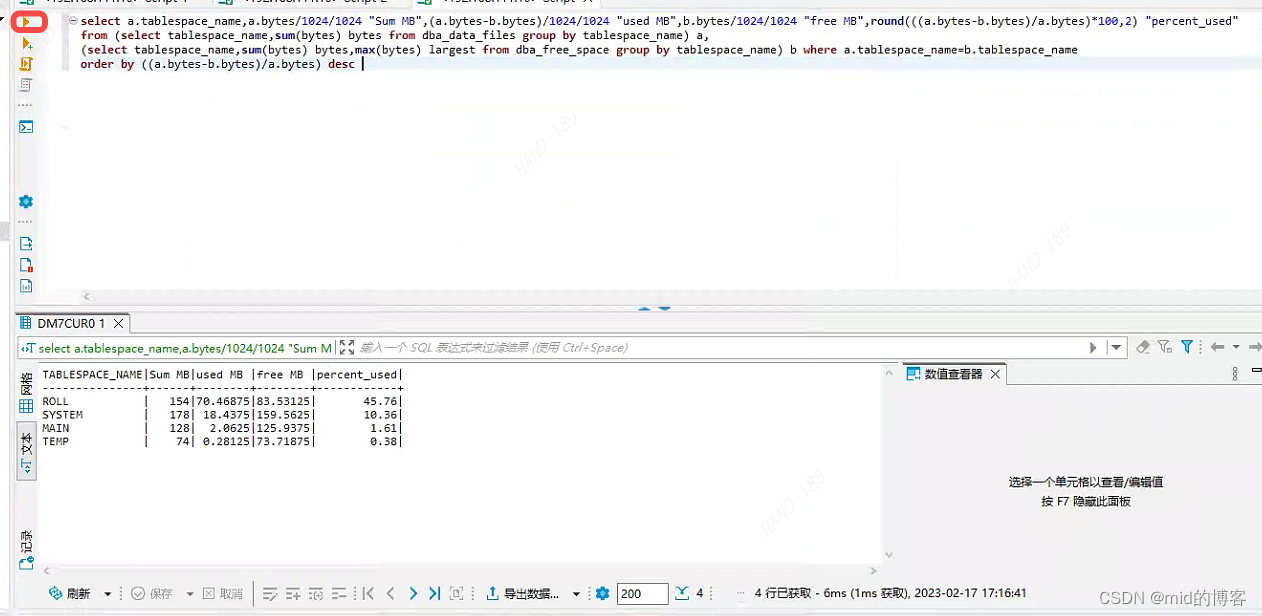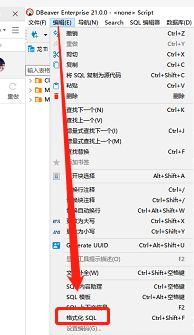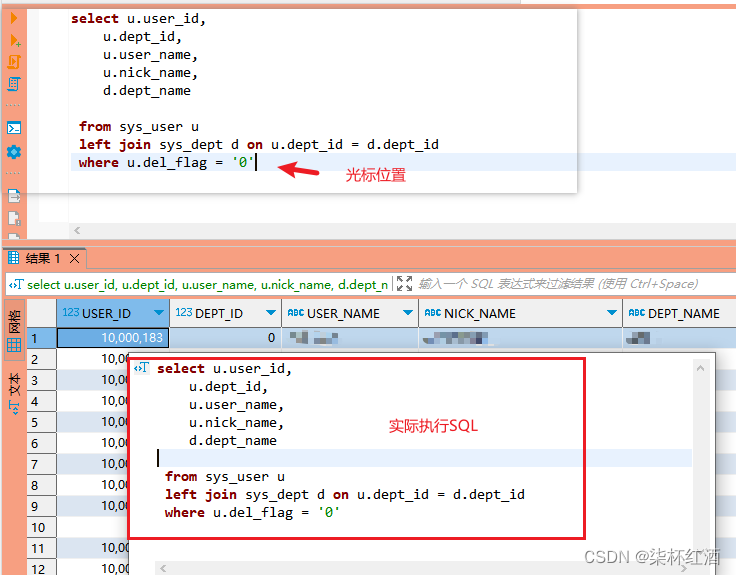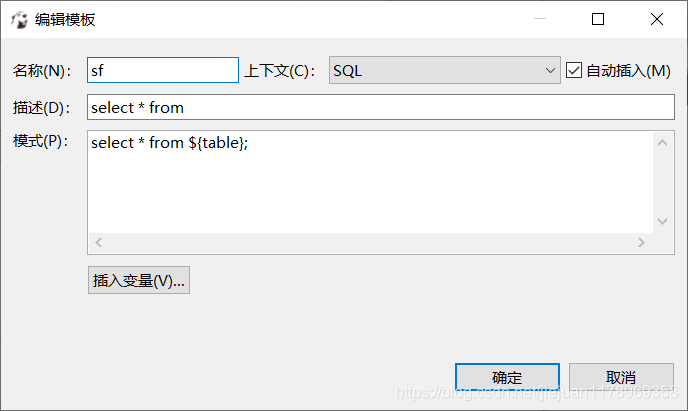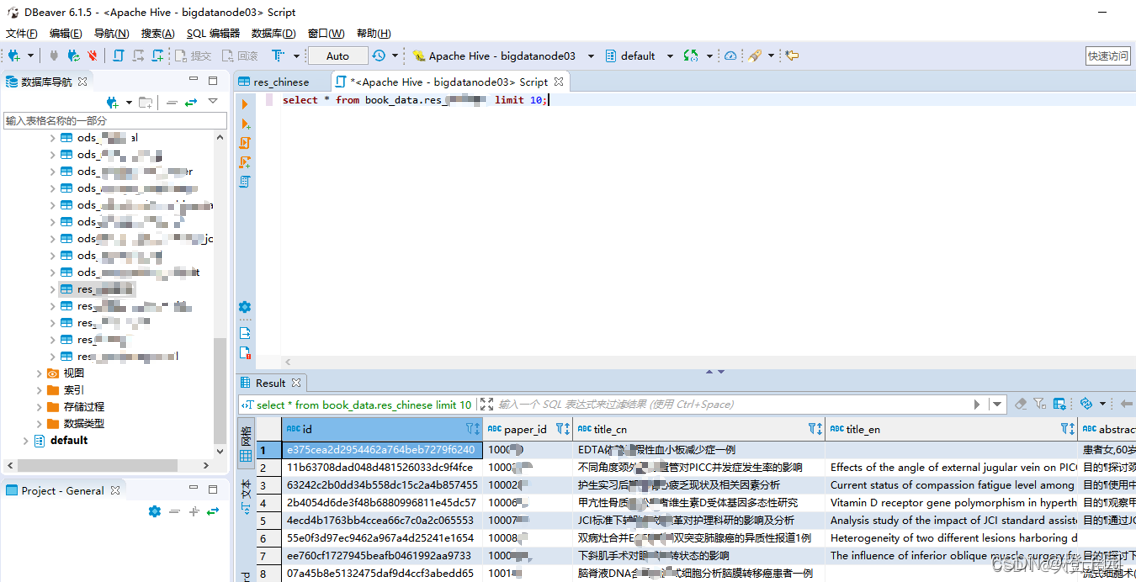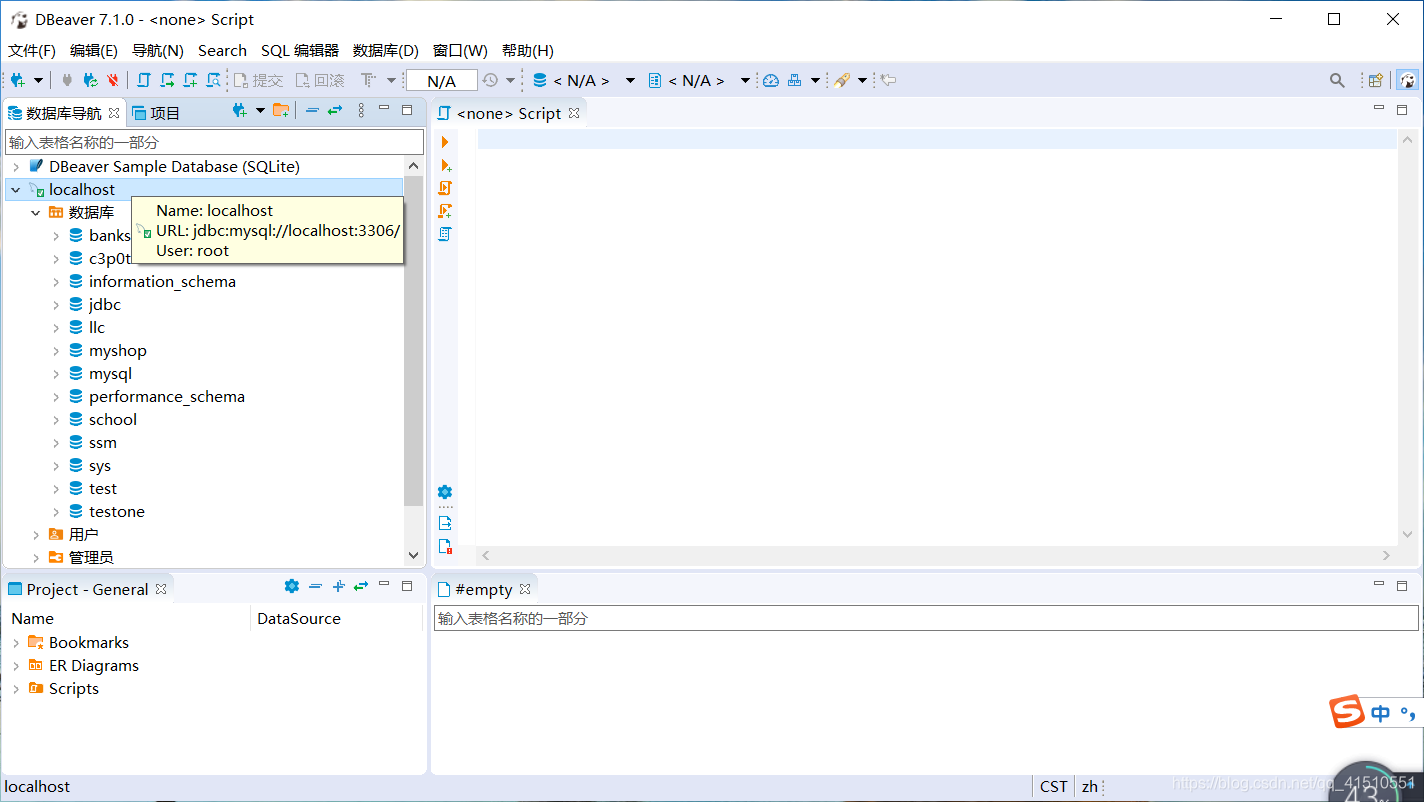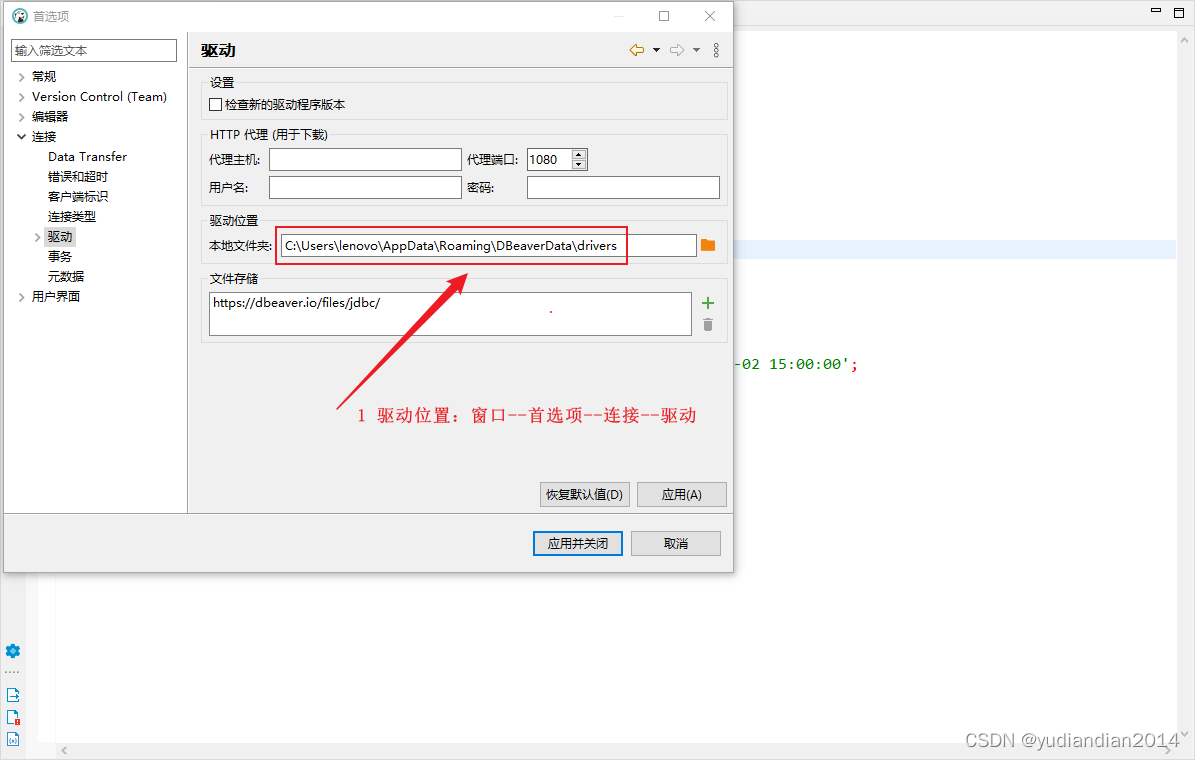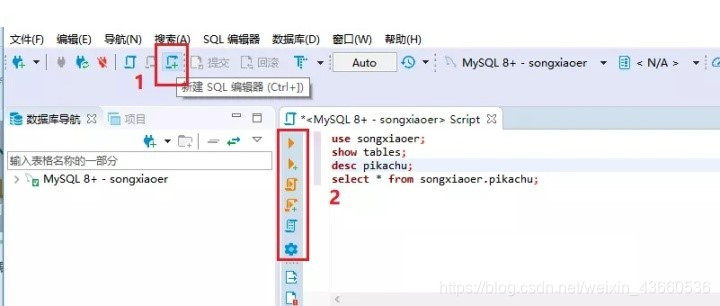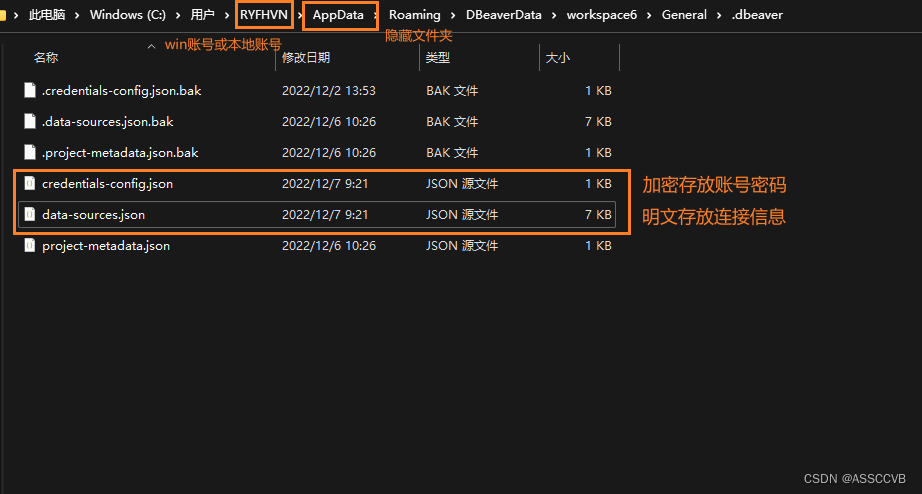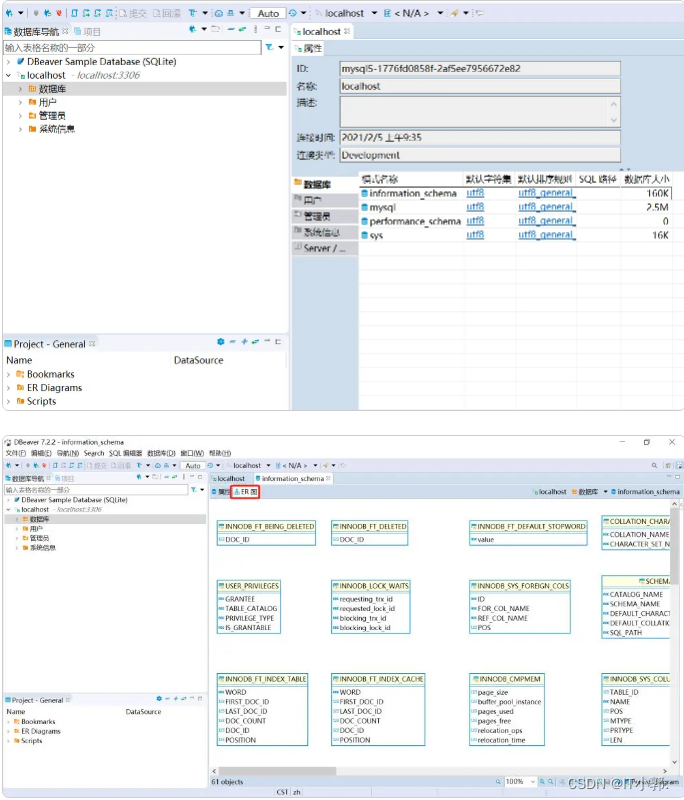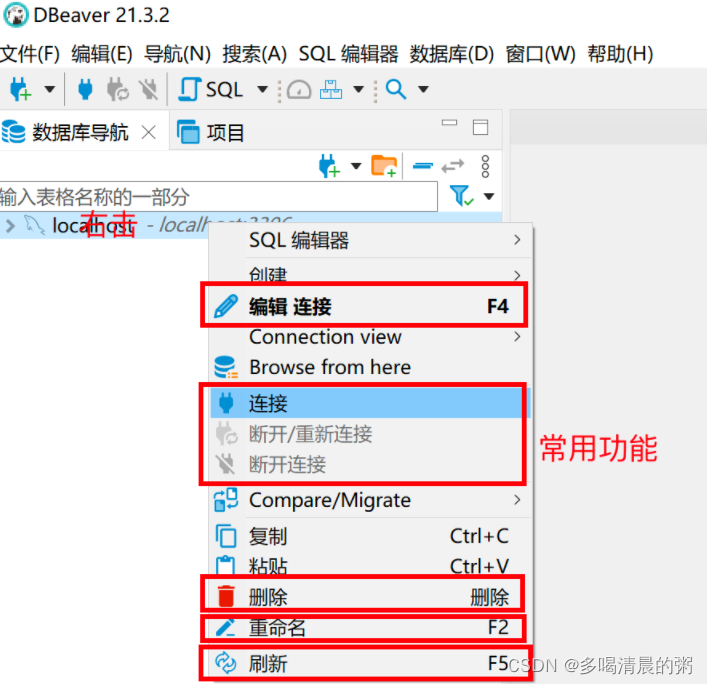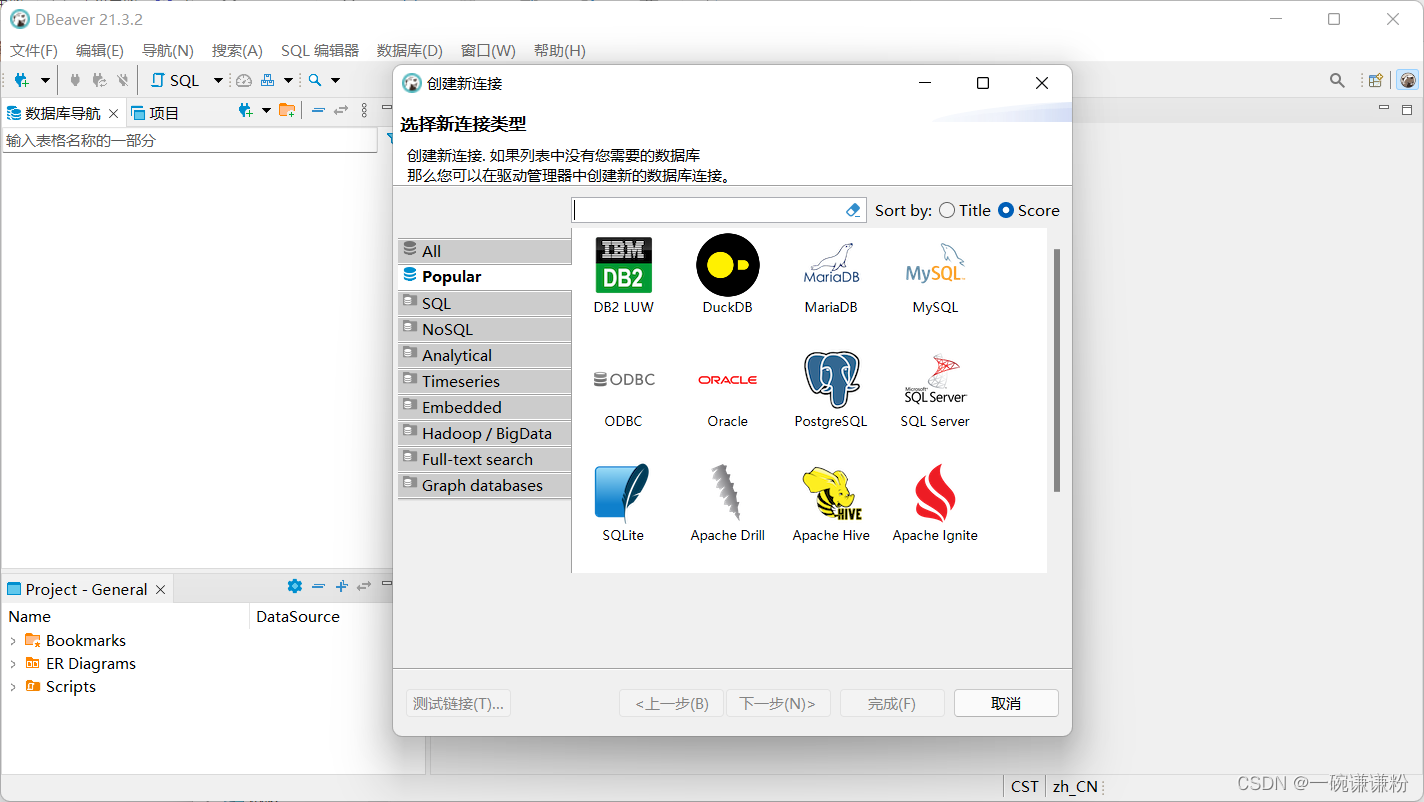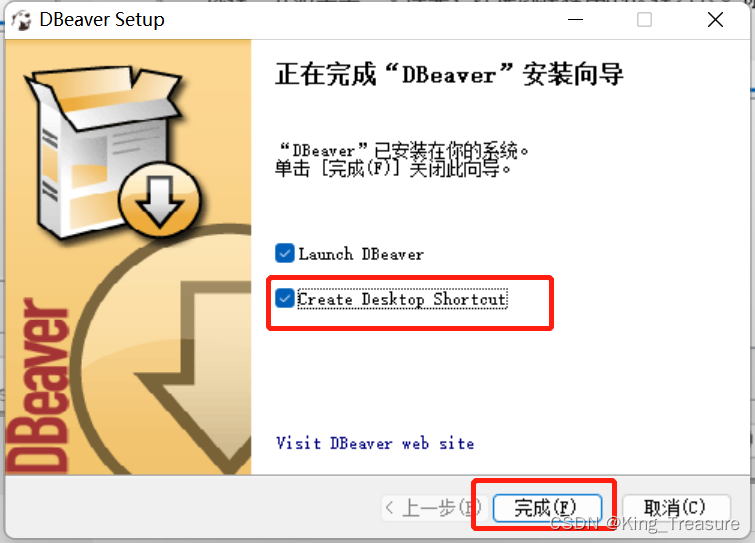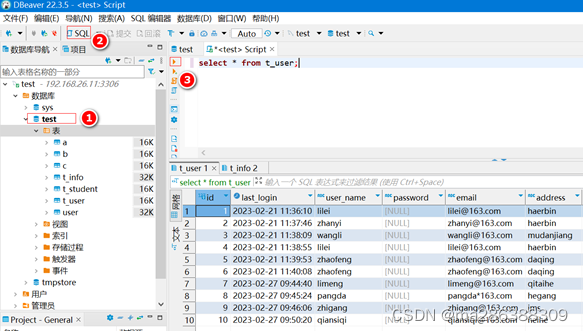java–JUC快速入门(彻底搞懂JUC)
文章目录
- java--JUC快速入门(彻底搞懂JUC)
- 1、学习多线程之前需要知道的一些概念。
- 2、JUC的结构
- 3、Lock锁(重点)
- 4、集合类不安全
- 5、Callable()
- 6、常用的辅助类
- 7、读写锁
- 8、阻塞队列
- 9、线程池
1、学习多线程之前需要知道的一些概念。
1.1 JUC是什么?
JUC是java.util.concurrent包的简称,在Java5.0添加,目的就是为了更好的支持高并发任务。让开发者进行多线程编程时减少竞争条件和死锁的问题!
我们在面试过程中也会经常问到这类问题!
1.2 进程与线程的区别:
进程 : 一个运行中的程序的集合; 一个进程往往可以包含多个线程,至少包含一个线程
java默认有几个线程? 两个 main线程 gc线程
线程 : 线程(thread)是操作系统能够进行运算调度的最小单位。
1.3 并发与并行的区别:
并发(多线程操作同一个资源,交替执行)
CPU一核, 模拟出来多条线程,天下武功,唯快不破,快速交替
并行(多个人一起行走, 同时进行)
CPU多核,多个线程同时进行 ; 使用线程池操作
1.4 线程有六个状态:
public enum State {// 新生NEW,// 运行RUNNABLE,// 阻塞BLOCKED,// 等待WAITING,//超时等待TIMED_WAITING,//终止TERMINATED;}
1.5 wait/sleep的区别:
- 来自不同的类: wait来自object类, sleep来自线程类
- 关于锁的释放:wait会释放锁, sleep不会释放锁
- 使用的范围不同: wait必须在同步代码块中, sleep可以在任何地方睡眠
2、JUC的结构
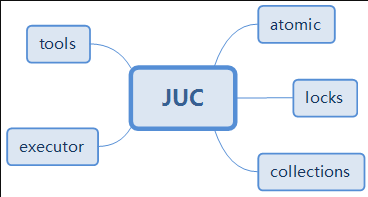
1,tools(工具类):又叫信号量三组工具类,包含有
1)CountDownLatch(闭锁) 是一个同步辅助类,在完成一组正在其他线程中执行的操作之前,它允许一个或多个线程一直等待
2)CyclicBarrier(栅栏) 之所以叫barrier,是因为是一个同步辅助类,允许一组线程互相等待,直到到达某个公共屏障点 ,并且在释放等待线程后可以重用。
3)Semaphore(信号量) 是一个计数信号量,它的本质是一个“共享锁“。信号量维护了一个信号量许可集。线程可以通过调用 acquire()来获取信号量的许可;当信号量中有可用的许可时,线程能获取该许可;否则线程必须等待,直到有可用的许可为止。 线程可以通过release()来释放它所持有的信号量许可。
2,executor(执行者):是Java里面线程池的顶级接口,但它只是一个执行线程的工具,真正的线程池接口是ExecutorService,里面包含的类有:
1)ScheduledExecutorService 解决那些需要任务重复执行的问题
2)ScheduledThreadPoolExecutor 周期性任务调度的类实现
3,atomic(原子性包):是JDK提供的一组原子操作类,
包含有AtomicBoolean、AtomicInteger、AtomicIntegerArray等原子变量类,他们的实现原理大多是持有它们各自的对应的类型变量value,而且被volatile关键字修饰了。这样来保证每次一个线程要使用它都会拿到最新的值。
4,locks(锁包):是JDK提供的锁机制,相比synchronized关键字来进行同步锁,功能更加强大,它为锁提供了一个框架,该框架允许更灵活地使用锁包含的实现类有:
1)ReentrantLock 它是独占锁,是指只能被独自占领,即同一个时间点只能被一个线程锁获取到的锁。
2)ReentrantReadWriteLock 它包括子类ReadLock和WriteLock。ReadLock是共享锁,而WriteLock是独占锁。
3)LockSupport 它具备阻塞线程和解除阻塞线程的功能,并且不会引发死锁。
5,collections(集合类):主要是提供线程安全的集合, 比如:
1)ArrayList对应的高并发类是CopyOnWriteArrayList,
2)HashSet对应的高并发类是 CopyOnWriteArraySet,
3)HashMap对应的高并发类是ConcurrentHashMap等等
下面及具体来是学习一下多线程创建及使用方法:
普通的线程代码, 之前都是用的thread或者runnable接口;
具体实现如下:
public class demo01 {public static void main(String[] args) {ThreadDemo threadDemo = new ThreadDemo();threadDemo.start();new Thread(new ThreadDemo2()).start();}
}class ThreadDemo extends Thread{@Overridepublic void run() {System.out.println("普通线程已开启(继承Thread)");}
}
class ThreadDemo2 implements Runnable{@Overridepublic void run() {System.out.println("普通线程已开启(实现Runnable接口)");}
}程序运行结果:

3、Lock锁(重点)
传统synchronized
synchronized是Java中的关键字,是一种同步锁。它修饰的对象有以下几种:
1. 修饰一个代码块,被修饰的代码块称为同步语句块,其作用的范围是大括号{}括起来的代码,作用的对象是调用这个代码块的对象;
2. 修饰一个方法,被修饰的方法称为同步方法,其作用的范围是整个方法,作用的对象是调用这个方法的对象;
3. 修改一个静态的方法,其作用的范围是整个静态方法,作用的对象是这个类的所有对象;
4. 修改一个类,其作用的范围是synchronized后面括号括起来的部分,作用主的对象是这个类的所有对象。
Lock 接口

实现类

reentrantLock构造器
public ReentrantLock() {sync = new NonfairSync(); //无参默认非公平锁}public ReentrantLock(boolean fair) {sync = fair ? new FairSync() : new NonfairSync();//传参为true为公平锁}公平锁: 十分公平: 可以先来后到,一定要排队
非公平锁: 十分不公平,可以插队(默认)
public class SaleTicketDemo {public static void main(String[] args) {Ticket ticket = new Ticket();new Thread(()->{for(int i = 0; i < 40; i++) ticket.sale();}, "a").start();new Thread(()->{for(int i = 0; i < 40; i++) ticket.sale();}, "b").start();new Thread(()->{for(int i = 0; i < 40; i++) ticket.sale();}, "c").start();}
}class Ticket {private int ticketNum = 30;private Lock lock = new ReentrantLock();public void sale() {lock.lock();try {if (this.ticketNum > 0) {System.out.println(Thread.currentThread().getName() + "购得第" + ticketNum-- + "张票, 剩余" + ticketNum + "张票");}//增加错误的发生几率Thread.sleep(10);} catch (Exception e) {e.printStackTrace();} finally {lock.unlock();}}}synchronized和lock锁的区别
- synchronized内置的java关键字,Lock是一个java类
- synchronized无法判断获取锁的状态, Lock可以判断是否获取到了锁
- synchronized会自动释放锁,Lock必须要手动释放锁!如果不是释放锁,会产生死锁
- synchronized 线程1(获得锁,阻塞),线程2(等待); Lock锁就不一定会等待下去
- synchronized 可重入锁,不可以中断的,非公平的; Lock锁,可重入的,可以判断锁,非公平(可自己设置);
- synchronized 适合锁少量的代码同步问题,Lock 适合锁大量的同步代码
Condition 精准的通知和唤醒线程
Condition是个接口,基本的方法就是await()和signal()方法;
Condition依赖于Lock接口,生成一个Condition的基本代码是lock.newCondition()
调用Condition的await()和signal()方法,都必须在lock保护之内,就是说必须在lock.lock()和lock.unlock之间才可以使用
Conditon中的await()对应Object的wait();
Condition中的signal()对应Object的notify();
Condition中的signalAll()对应Object的notifyAll()。
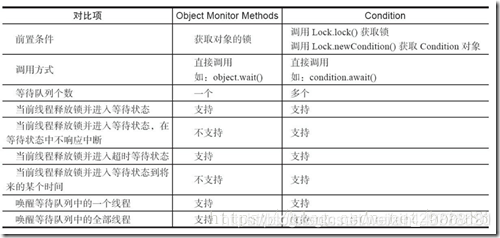
Condition常见例子(生产者消费者模式(完成加一减一各一次操作)):
import java.util.concurrent.locks.Condition;
import java.util.concurrent.locks.Lock;
import java.util.concurrent.locks.ReentrantLock;public class PC {public static void main(String[] args) {a a = new a();new Thread(()->{for (int i =0;i<10;i++){a.increment();}},"A").start();new Thread(()->{for (int i =0;i<10;i++){a.decrease();}},"B").start();}}
class a{public int nummber=0;Lock lock = new ReentrantLock();Condition condition = lock.newCondition();public void increment(){lock.lock();try {while(nummber!=0){condition.await();}nummber++;System.out.println(Thread.currentThread().getName()+">>"+nummber);condition.signalAll();}catch (InterruptedException e) {e.printStackTrace();} finally {lock.unlock();}}public void decrease(){lock.lock();try {while(nummber!=1){condition.await();}nummber--;System.out.println(Thread.currentThread().getName()+">>"+nummber);condition.signalAll();}catch (InterruptedException e) {e.printStackTrace();} finally {lock.unlock();}}
}运行结果:

4、集合类不安全
list 不安全
//java.util.ConcurrentModificationException 并发修改异常!
public class ListTest {public static void main(String[] args) {//并发下 arrayList 是不安全的/*** 解决方案* 1. 使用vector解决* 2. List<String> arrayList = Collections.synchronizedList(new ArrayList<>());* 3. List<String> arrayList = new CopyOnWriteArrayList<>();*///copyOnWrite 写入时复制 COW 计算机程序设计领域的一种优化策略//多个线程调用的时候, list, 读取的时候固定的,写入的时候,可能会覆盖//在写入的时候避免覆盖造成数据问题//CopyOnWriteArrayList 比 vector牛逼在哪里//读写分离List<String> arrayList = new CopyOnWriteArrayList<>();for (int i = 0; i < 100; i++) {new Thread(()->{arrayList.add(UUID.randomUUID().toString().substring(0,5));System.out.println(arrayList);},String.valueOf(i)).start();}}
}set 不安全
/*** 同理可证*/
public class SetTest {public static void main(String[] args) {// Set<String> set = new HashSet<>();//如何解决hashSet线程安全问题//1. Set<String> set = Collections.synchronizedSet(new HashSet<>());Set<String> set = new CopyOnWriteArraySet<>();for (int i = 0; i < 100; i++) {new Thread(() -> {set.add(UUID.randomUUID().toString().substring(0, 5));System.out.println(set);}, String.valueOf(i)).start();}}
}hashSet底层是什么? hashMap
public HashSet() {map = new HashMap<>();
}// add 的本质就是 map 的 key key是无法重复的
public boolean add(E e) {return map.put(e, PRESENT)==null;
}
private static final Object PRESENT = new Object();//这是一个不变的值HashMap 不安全
map的基本操作

5、Callable()

- 可以有返回值
- 可以抛出异常
- 方法不同, run() => call()


public class CallableTest {public static void main(String[] args) throws ExecutionException, InterruptedException {FutureTask<Integer> futureTask = new FutureTask<>(new MyThread());new Thread(futureTask,"a").start();System.out.println(futureTask.get());}
}class MyThread implements Callable<Integer> {@Overridepublic Integer call() throws Exception {System.out.println("call()方法被调用了");return 1024;}
}6、常用的辅助类
CountDownLatch

//计数器
public class demo02 {public static void main(String[] args) throws InterruptedException {//相当于计数器CountDownLatch countDownLatch = new CountDownLatch(5);//计数器总数是5,当减少为0,任务才继续向下执行for (int i = 1; i <6 ; i++) {new Thread(()->{System.out.println(Thread.currentThread().getName()+"==>start");countDownLatch.countDown();}).start();}countDownLatch.await();System.out.println("main线程继续向下执行");}
}结果:

原理:
countDownLatch.countDown(); //数量减1
countDownLatch.await();// 等待计数器归零,然后再向下执行
每次有线程调用countDown()数量-1,假设计数器变为0,countDownLatch.await();就会被唤醒,继续执行
cyclicBarrier

加法计数器
public class CyclicBarrierDemo {public static void main(String[] args) {/*** 集齐77个龙珠召唤神龙*/// 召唤龙珠的线程CyclicBarrier cyclicBarrier = new CyclicBarrier(7, ()->{System.out.println("召唤神龙成功! ");});for (int i = 0; i < 7; i++) {int temp = i;//lambda 能拿到i吗new Thread(()->{System.out.println(Thread.currentThread().getName() + "收集" + temp + "个龙珠");try {cyclicBarrier.await();} catch (InterruptedException e) {e.printStackTrace();} catch (BrokenBarrierException e) {e.printStackTrace();}}).start();}}
}运行结果:

Semaphore

public class SemaphoreTest {public static void main(String[] args) {Semaphore semaphore = new Semaphore(3);for (int i = 0; i < 6; i++) {int temp = i;new Thread(()->{try {semaphore.acquire(); //获取System.out.println(temp + "号车抢到车位");TimeUnit.SECONDS.sleep(5);} catch (InterruptedException e) {e.printStackTrace();} finally {semaphore.release(); //释放System.out.println(temp + "号车离开车位");}}).start();}}
}运行结果:

原理:
semaphore.acquire(); //获取信号量,假设如果已经满了,等待信号量可用时被唤醒
semaphore.release(); //释放信号量
作用: 多个共享资源互斥的使用!并发限流,控制最大的线程数
7、读写锁
ReadWriteLock

package com.czp.lock;import java.util.HashMap;
import java.util.Map;
import java.util.concurrent.TimeUnit;
import java.util.concurrent.locks.ReentrantReadWriteLock;/*** 独占锁(写锁) 一次只能由一个线程占有* 共享锁(读锁) 一次可以有多个线程占有* readWriteLock* 读-读 可以共存* 读-写 不能共存* 写-写 不能共存*/
public class ReadWriteLock {public static void main(String[] args) {MyCacheLock myCache = new MyCacheLock();//写入操作for (int i = 0; i < 6; i++) {int temp = i;new Thread(() -> {myCache.put(temp + "", temp + "");}, String.valueOf(i)).start();}//读取操作for (int i = 0; i < 6; i++) {int temp = i;new Thread(() -> {myCache.get(temp + "");}, String.valueOf(i)).start();}}
}class MyCacheLock {private volatile Map<String, Object> map = new HashMap<>();//读写锁private java.util.concurrent.locks.ReadWriteLock lock = new ReentrantReadWriteLock();// 存,写入的时候只有一个人操作public Object get(String key) {lock.readLock().lock();Object o = null;try {System.out.println(Thread.currentThread().getName() + "读取");try {TimeUnit.SECONDS.sleep(2);} catch (InterruptedException e) {e.printStackTrace();}o = map.get(key);System.out.println(Thread.currentThread().getName() + "读取ok" + o);} catch (Exception e) {e.printStackTrace();} finally {lock.readLock().unlock();}return o;}public void put(String key, Object value) {lock.writeLock().lock();try {System.out.println(Thread.currentThread().getName() + "写入" + key);map.put(key, value);System.out.println(Thread.currentThread().getName() + "写入完毕");} catch (Exception e) {e.printStackTrace();} finally {lock.writeLock().unlock();}}}class MyCache {private volatile Map<String, Object> map = new HashMap<>();public Object get(String key) {System.out.println(Thread.currentThread().getName() + "读取");Object o = map.get(key);System.out.println(Thread.currentThread().getName() + "读取ok" + o);return o;}public void put(String key, Object value) {System.out.println(Thread.currentThread().getName() + "写入" + key);map.put(key, value);System.out.println(Thread.currentThread().getName() + "写入完毕");}}8、阻塞队列


Blockqueue


什么情况下我们会使用阻塞队列,多线程并发处理,线程池!
如何使用队列?
添加 移除
四组API

/*** 抛出异常*/public static void test1() {//队列的大小ArrayBlockingQueue queue = new ArrayBlockingQueue<>(3);System.out.println(queue.add("a"));System.out.println(queue.add("b"));System.out.println(queue.add("c"));//java.lang.IllegalStateException: Queue full//System.out.println(queue.add("d"));System.out.println("----------------------");System.out.println(queue.remove());System.out.println(queue.remove());System.out.println(queue.remove());//java.util.NoSuchElementExceptionSystem.out.println(queue.remove());//抛出异常} /*** 有返回值没有异常*/public static void test2(){ArrayBlockingQueue queue = new ArrayBlockingQueue(3);System.out.println(queue.offer("a"));System.out.println(queue.offer("b"));System.out.println(queue.offer("c"));
// System.out.println(queue.offer("d")); //offer 不抛出异常System.out.println(queue.poll());System.out.println(queue.poll());System.out.println(queue.poll());
// System.out.println(queue.poll()); //null 不抛出异常} /*** 等待阻塞*/public static void test3() throws InterruptedException {ArrayBlockingQueue queue = new ArrayBlockingQueue(3);queue.put("a");queue.put("b");queue.put("c");
// queue.put("c"); 队列没有位置就会阻塞System.out.println(queue.take());System.out.println(queue.take());System.out.println(queue.take());}SynchronizedQueue 同步队列
没有容量,
进去一个元素,必须等待取出来之后,才能再往里面放一个元素
put take
/*** 同步队列* 和其他的lockQueue 不一样, SynchronousQueue 不存储元素*/
public class SyncQueue {public static void main(String[] args) {SynchronousQueue<String> synchronousQueue = new SynchronousQueue<>(); //同步队列new Thread(()->{try {System.out.println(Thread.currentThread().getName() + "put 1");synchronousQueue.put("1");System.out.println(Thread.currentThread().getName() + "put 2");synchronousQueue.put("2");System.out.println(Thread.currentThread().getName() + "put 3");synchronousQueue.put("3");} catch (InterruptedException e) {e.printStackTrace();}},"T1").start();new Thread(()->{try {TimeUnit.SECONDS.sleep(3);System.out.println(Thread.currentThread().getName() + "=>" + synchronousQueue.take());TimeUnit.SECONDS.sleep(3);System.out.println(Thread.currentThread().getName() + "=>" + synchronousQueue.take());TimeUnit.SECONDS.sleep(3);System.out.println(Thread.currentThread().getName() + "=>" + synchronousQueue.take());} catch (InterruptedException e) {e.printStackTrace();} finally {}},"T2").start();}
}9、线程池
因为之前有写过这个文章,可以转到以下链接继续学习:
https://blog.csdn.net/weixin_43888181/article/details/116518664?spm=1001.2014.3001.5501
注明:该笔记是通过学习bilibili的狂神说java的视频《JUC并发编程》及个人学习总结所得的笔记。
https://www.bilibili.com/video/BV1B7411L7tE?from=search&seid=15216587814524323096&spm_id_from=333.337.0.0
